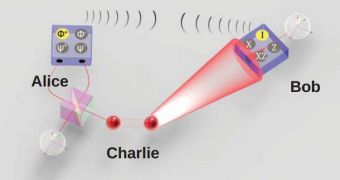Experts from the University of Science and Technology of China in Shanghai, led by scientist Juan Yin, have recently been able to teleport photons through free space, over a distance of 97 kilometers (58 miles).
With this achievement, they demonstrated that it might soon become possible to establish quantum communications between ground facilities and satellites in low-Earth orbit. In the future, it may be possible to do the same for spacecraft in geosynchronous and geostationary orbits.
It is very important to note here that the new study refers to the term teleportation in its scientific sense, which is the transfer of information from particles or objects at one location to corresponding particles or objects at another location, without actually traveling through the space between the two.
Basically, researchers only teleport the information that describes the target structure, not the object itself. This is definitely not the same type of device as used in most science-fiction movies, experts say.
Photon teleportation has been used by physicists in optics laboratories around the world since 1997. The new study is remarkable because it managed to transmit photon data over such a huge distance.
The phenomenon is made possible by quantum entanglement, a property of quantum systems in which particles are connected to each other over space and time. Entangled particles will always have the same spin; changing the spin on one instantly leads to the other experiencing a change in spin as well.
This is baffling when applied to very large distances. The same effect takes place between a particle here on Earth and another in the Andromeda Galaxy. What puzzled Albert Einstein was the fact that the change is immediate, not taking into account the theoretical speed limit of the Universe, that of light.
This is why the famous expert called quantum entanglement a “spooky action at a distance.” Photon teleportation, the Chinese experts say, was essential for the development of quantum cryptography, a coding technique in which messages cannot be intercepted, because they do not travel.
The main innovation the Chinese team accomplished was developing a steering mechanism for the photon beams, which keeps them on target, and limits the number of interactions they have with the medium through which they are traveling. Quantum entanglement is a very fragile state, easily broken through outside interference.
“The successful quantum teleportation over such channel losses in combination with our high-frequency and high-accuracy [aiming] technique show the feasibility of satellite-based ultra-long-distance quantum teleportation,” Juan explains, quoted by Technology Review.

 14 DAY TRIAL //
14 DAY TRIAL //